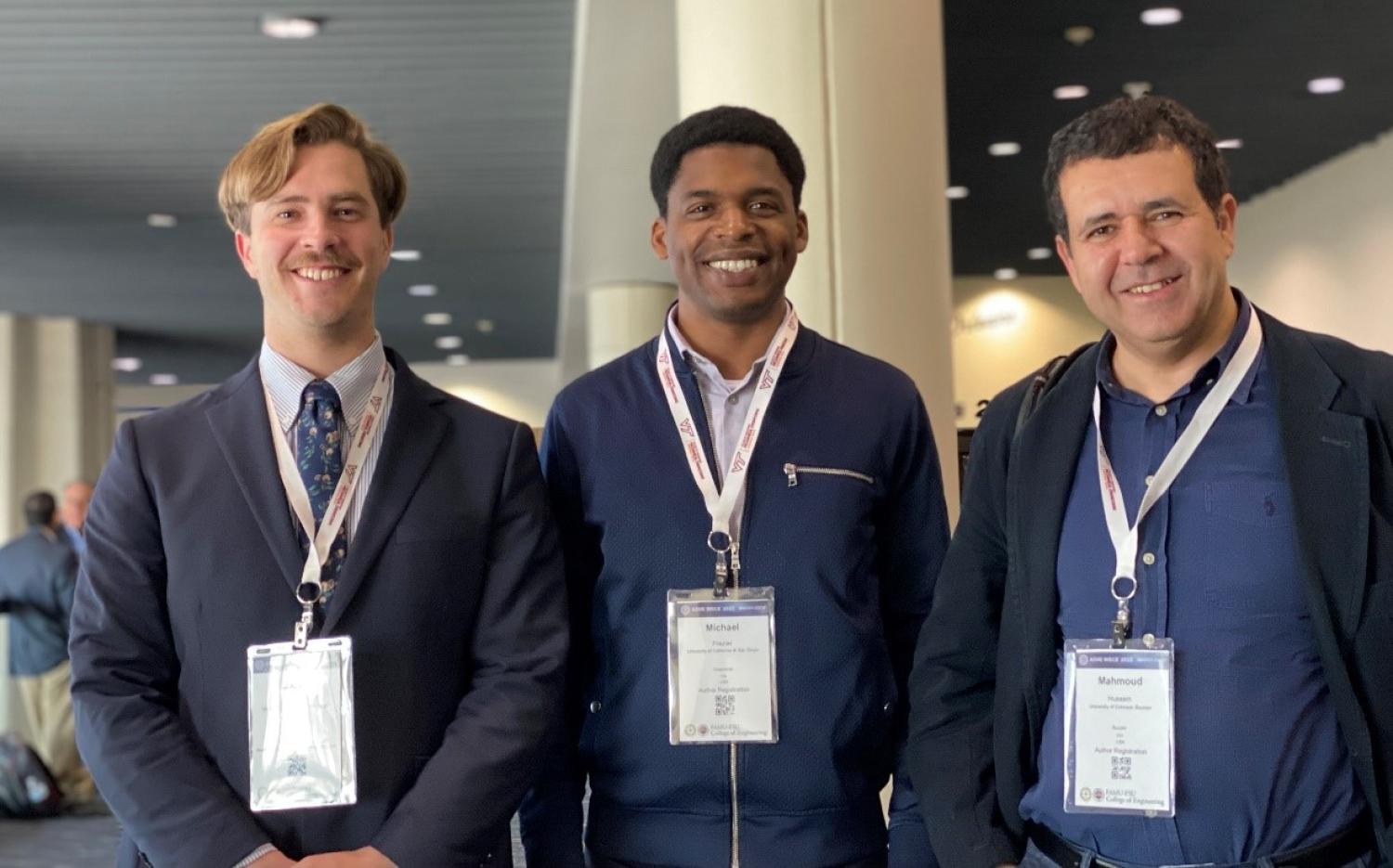PhD grad training next generation of aerospace leaders

Three "generations" of PhDs: Asst. Prof. Michael Frazier (center); with his PhD advisor, CU Boulder Prof. Mahmoud Hussein (right); and Frazier's current PhD student, Jack Pechac (left).
Michael J. Frazier (AeroEngr MS’11, PhD’15) discovered the dream engineering job he never knew he was looking for: university professor.
In high school, as an undergraduate, and even as a master’s student, Frazier was sure an industry job was in his future, but a drive for more knowledge and research sent him down a different path.
Today he is performing investigations at the frontiers of science, teaching budding young engineers, and advising doctoral students of his own.
“The research is the part of the job I love most,” Frazier said. “There are unexpected and novel results. Originally, I did not plan to complete a PhD, but am glad that I did. I get to think about a variety of subjects and pursue my own scientific interests. If I had gone into industry, my tasks may have been more routine and life might be more mundane.”
Desire to Learn
Initially, Frazier just wanted to learn more. His undergraduate degree at Embry Riddle Aeronautical University gave him a strong aerospace base, but he wanted a deeper understanding, which led him to start a master’s at the University of Colorado Boulder.
“I thought I’d gain more knowledge with the MS degree, and then negotiate for a higher starting salary when I entered an industry job. But once I experienced the research aspect of grad school, I didn’t want to stop, and so I got a PhD,” he said.
After graduation, Frazier moved to Caltech, and then ETH Zurich, for a two-year postdoc. Since 2017, he has led a research laboratory at the University of California San Diego as a tenure-track assistant professor studying metamaterials – materials that have extreme or unusual properties not found nature.
Metamaterials Research
“Nature adheres to the rules of chemistry that dictate the interactions of atoms at the small scale, which ultimately influence the observed properties of materials. Metamaterials comprise 3D-printable structural units analogous to atoms in natural materials; however, since we rather than nature control every aspect of these artificial atoms, we are able to set the rules and realize materials with performance beyond nature,” Frazier said.
It is a relatively young area of research with broad applications in many fields, including optics, acoustics, mechanics, and even biology.
“I really enjoy the physics of it. We’re investigating and discovering things nobody else has previously looked at. In science, most advances are incremental; however, the prospect of uncovering some truth or developing some insight that fosters a major leap forward is a huge personal driver.”
Example of Frazier's computational research, depicting a mechanical phase transformation within a hierarchical hexagonal lattice comprising 21,120 multi-stable elements (i.e., pistons). The phases (i.e., piston heights) can be organized into custom morphologies (e.g., a bee). The results may have implications for morphable surfaces. C. Wang and M. J. Frazier (2023), "Phase patterning in multi-stable metamaterials: Transition wave stabilization and mode conversion".
It is an area of study he started in at CU Boulder, working under Professor Mahmoud Hussein, a pioneer in phononics, a broader field of research that incorporates acoustic metamaterials.
”When Michael joined my group he was a bit uncertain in the beginning about whether an academic career would be best for him. Within just a few months, the thought started creeping into his mind. I could feel it,” Hussein said. “He progressed at a most impressive rate over the years he spent with us. By his final year, I noticed that he was enjoying going deep into his research problem and attacking every aspect of it with great detail, imagination, and rigor. At that point, it was clear to me that a faculty career was a path he could pursue with success."
Student to Teacher
Making the transition from being a PhD student to advising them has been a journey. Frazier is naturally low key and has learned the importance of being direct and intentional when leading students.
“I don’t think of myself as a pushy professor, but I make it clear when expectations are not being met,” he said. “Sometimes you need to do that so students move in the right direction and at the right speed. It took me a couple years to figure that out.”
His efforts have paid off, with his first PhD student graduating earlier this year. His second is expected to defend his doctoral dissertation in spring 2024.
“During a PhD student’s doctoral defense, it’s not only the student being judged — it’s also the professor. Your colleagues want to see that you are capable of selecting a worthy topic and executing a research plan, a major part of which is effectively guiding the graduate student up to the moment of the defense,” Frazier said.
Frazier teaches mechanics and materials classes, leading instruction in structures, solid mechanics, finite elements, and dynamics.
“I really like passing on that knowledge” he said, “Hopefully, in a manner that allows students to absorb the information faster and more deeply than when I learned it”.
His biggest challenge as a professor has been funding. Conducting research requires earning grants, and Frazier said the process can be frustrating. “I spend a lot of time conceiving what I think is an interesting proposal, and then, in writing, try to convey its intellectual merit and broader impact as well as anticipate reviewer questions. Yet, this effort may still not yield the desired result.”
He earned his first large award last year — $365,000 from the National Science Foundation to develop a new class of energy-absorbing metamaterials.

